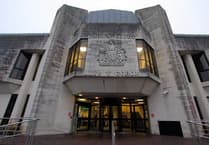An Eisteddfod Chair made by a Belgian First World War refugee will go on display at Aberystwyth Arts Centre this month as part of a new exhibition about the impact of war and displacement in Wales.
Curated by researchers from Aberystwyth University’s Centre for the Movement of People, the exhibition brings together artworks and artefacts from people who were displaced to Wales after fleeing war and violence in the first half of the twentieth century. It tells the stories of refugees, prisoners of war, and evacuees from across Britain who sought sanctuary in Wales.
The exhibition also highlights the experiences of more recent arrivals, including those displaced by conflicts in Ukraine and Syria.
One of the works on display is the 1923 Eisteddfod chair intricately carved by Emile de Vynk, a Belgian refugee who, along with his family, was offered refuge in Criccieth in 1914, after fleeing the hostilities of the First World War. Paintings by Fred Uhlman, a Jewish artist persecuted by the Nazis, are also included, alongside evocative photographs of Basque children evacuated in 1937 and English evacuees from 1940 onwards.
Andrea Hammel, Professor of German and Director of the Centre for the Movement of People, said: “This exhibition aims to highlight the long history of displacement caused by war. While last month’s commemorations of the end of the Second World War in Europe focused mainly on combatants and local communities, we want to show the experience of those who had to leave their homes. By 1945 there were 60 million displaced people in Europe alone, and Wales provided sanctuary to many.”
The exhibition juxtaposes historical art and artefacts with contemporary works by professional and community artists from Syria and Ukraine who have resettled in Wales in the past decade.
Co-curator Dr Morris Brodie added: “We would like to invite visitors to reflect on the history of displacement to Wales, and on the lessons to be learnt today. We collected contributions from the descendants of Italian prisoners of war, as well as the Polish and the South Asian community. We are also showing works of art created by members of our community whose displacement is much more recent.”
One such artist is Victoria Kazimova, whose paintings explore the impact of displacement on identity.
“Drawing on the visual language of European religious painting, I portray contemporary Ukrainians - often children - using traditional patterns as symbols of identity and belonging to their nation - a sense that becomes especially vital in times of displacement,” Victoria said.
Another exhibit is a model of Aleppo Castle by Syrian blacksmith Mohamad Karkoubi, now based in Aberystwyth. The model encapsulates his memories of Syria before the war.
“Creating the model makes me nostalgic for my childhood,” he said.
The exhibition is on display in Aberystwyth Arts Centre’s Gallery 2 from 14 June-27 October 2025, before moving to Oriel Senedd in Cardiff Bay.
A public launch event will take place on 14 June at 4.30pm, and an Artist’s Talk on 24 June at 4.30pm.




.png?width=209&height=140&crop=209:145,smart&quality=75)
Comments
This article has no comments yet. Be the first to leave a comment.